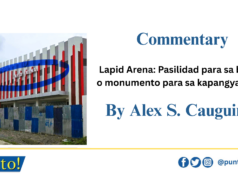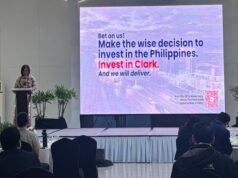CITY OF SAN FERNANDO – The Pampanga provincial board has repealed Ordinance 261, a local anti-overloading law, in a special session on Monday to be able to quash the questioned provisions in the implementing rules and regulations (IRR) made by the technical working group (TWG) formed by Gov. Eddie Panlilio.
Except for Board Member Ricardo Yabut, one of the two sponsors of the ordinance, the board voted overwhelmingly to scrap it during a special session held after a public hearing also on Monday.
The board junked the ordinance through Resolution No. 348, Vice Gov. Joseller Guiao said.
The ordinance was repealed some two weeks before this and its IRR are fully implemented on Feb. 1.
As of Monday, at least 811 truck owners and operators have complied, getting accreditation for at least 2,737 trucks, according to provincial environment officer Sallie Adonis.
The board gave weight to the opposition of the Pampanga Truckers Association Inc. (PTOA) and the Benedicto Lacsamana-led Federation of Pampanga Truckers Inc. (FPTI) against the policy to cut the metal sidings of trucks.
These two groups had clamored for the use of weighing scales instead.
“Vindicated!” Lacsamana said in reaction to the repeal.
Mike Tapang, which led another faction of the FPTI and which represented the truckers groups in the TWG, met the repeal with sadness and frustration.
“How do we now avoid overloading and the deterioration of our roads and bridges?” Tapang asked.
Panlilio was not available for comments at press time.
It was the first time that Guiao and the provincial board resorted to repeal an ordinance to end a conflict, if not a confusion, over the IRR.
Guaio said the repeal gave “immediate relief” to the truckers.
He said he and the board decided for a repeal when during the special session, Panlilio said he was not moving to suspend the implementation of the ordinance.
Guiao said the “IRR did not conform to the spirit of the ordinance”—a position that he had taken during the public hearing.
TENSION
But before this has happened, a tension briefly broke out again at the grounds of the provincial capitol here on Monday as three groups of truckers opposing or favoring the IRR faced off a few hours before the provincial board began its public hearings on the issue
A short scuffle ensued when Ariel Laxa, a director of the Lacsamana-led FPTI pulled the posters held by a member of the Tapang-led FPTI at around 10 a.m. as the latter and five more men silently walked in front of the Lacsamana-led picket.
The man quickly disentangled and walked away. The police, counting 20 in all, hastily intervened, standing midway of the Tapang and Lacsamana groups.
Laxa tore the posters into pieces. Somebody set these on fire. Lacsamana walked to the burning posters and spit on these. Four colleagues of Lacsamana brought a white coffin next to the burning posters.
The coffin, according to Laxa, symbolized the “death of the quarry industry” as a consequence of a policy in the IRR to cut the metal sidings of trucks to conform with standard dimensions.
In streamers, the Lacsamana-led FPTI demanded for the resignation of Panlilio who, they claimed, could not solve their problem.
As this happened, the police and the capitol’s custodian forces closed the main entrance of the capitol, apparently to avert a repeat of a siege by truckers and retrenched quarry workers last Jan. 5.
Supt. Benjamin Medina , chief of the San Fernando police, estimated the number of protesters this Monday at 250.
By 10:30 a.m., the PTOA and Lacsamana-led FPTI positioned themselves at the front gate of the Benigno Aquino Hall near the capitol. The Tapang-led FPTI occupied the right gate of the hall. Again, the police were between them.
Both camps blared loud sound systems. Each carried placards and streamers bandying their opposition or support to the controversial local law, Ordinance 261.
In the public hearing, the provincial board allowed 15 representatives from each group to attend.
PUBLIC HEARING
Starting off the hearing, Vice Gov. Joseller Guiao immediately stated that the ordinance, sponsored by Board Members Crisostomo Garbo and Ricardo Yabut and approved by Panlilio last October, did not need an IRR.
“The ordinance is sufficient as it is. I am surprised that an IRR was made,” he said.
First called to speak, Lacsamana said the IRR was “unconstitutional” because the use of volume, than weight, in determining overloading did not conform to Republic Act 8794, the motor vehicles usage law in which overloading is banned.
Lacsamana also demanded the replacement of Tapang as their group’s representative in the technical working group (TWG).
It was the TWG that formulated the IRR per the instruction of Panlilio as chair of the accreditation committee, according to TWG chair and provincial engineering chief Olympio Pangan.
Guiao said the ordinance did not order the governor to make an IRR.
“The IRR did not conform to the spirit of the ordinance. The [provincial board] was not consulted on the IRR. Sinolo nyo. Parang mas malakas, mabagsik ang IRR sa ordinance (You did a solo act. The IRR is stronger, vicious than the ordinance),” the vice governor said.
Castigating Pangan further, Guiao said: Napakasimple nito. (This is very simple). You only have to buy weighing scales. Anong kalohokan ito (What foolish solution is this)? Ba’t pinahihirapan nyo ang mga truckers. Dapat pinadadali nyo ang pagnenegosyo. Ba’t ang arte nyo (Why do you make it hard for the truckers? You should instead be making it easy for business. Why are you so diffident)?”
Pangan excused himself from the microphone.
Tapang said in the hearing that the policy of cutting was discussed with Lacsamana in a meeting in August and two meetings last November.
Video footage of the November meetings showed that Lacsamana did not oppose the cutting policy.
The accreditation committee last week diminished the dual powers of Tapang in the TWG, making him representative only of the small quarry operators.
It was “out of social responsibility” that the FPTI under him moved to stop overloading.
Rene Romero, president of the Advocacy for the Development of Central Luzon, did not push for the repeal and urged instead the provincial government to buy weighing scales and construct weighing bridges.
Aldrico Gaduena, alternate of Land Transportation Office in the TWG, said the ordinance was perfect. It, in fact, could help the LTO curb overloading and corruption by law enforcers on truckers.
Under RA 8794, he said weight is determined by axel loading (13.5 tons per axel) or through the registered gross vehicle weight.
Except for Board Member Ricardo Yabut, one of the two sponsors of the ordinance, the board voted overwhelmingly to scrap it during a special session held after a public hearing also on Monday.
The board junked the ordinance through Resolution No. 348, Vice Gov. Joseller Guiao said.
The ordinance was repealed some two weeks before this and its IRR are fully implemented on Feb. 1.
As of Monday, at least 811 truck owners and operators have complied, getting accreditation for at least 2,737 trucks, according to provincial environment officer Sallie Adonis.
The board gave weight to the opposition of the Pampanga Truckers Association Inc. (PTOA) and the Benedicto Lacsamana-led Federation of Pampanga Truckers Inc. (FPTI) against the policy to cut the metal sidings of trucks.
These two groups had clamored for the use of weighing scales instead.
“Vindicated!” Lacsamana said in reaction to the repeal.
Mike Tapang, which led another faction of the FPTI and which represented the truckers groups in the TWG, met the repeal with sadness and frustration.
“How do we now avoid overloading and the deterioration of our roads and bridges?” Tapang asked.
Panlilio was not available for comments at press time.
It was the first time that Guiao and the provincial board resorted to repeal an ordinance to end a conflict, if not a confusion, over the IRR.
Guaio said the repeal gave “immediate relief” to the truckers.
He said he and the board decided for a repeal when during the special session, Panlilio said he was not moving to suspend the implementation of the ordinance.
Guiao said the “IRR did not conform to the spirit of the ordinance”—a position that he had taken during the public hearing.
TENSION
But before this has happened, a tension briefly broke out again at the grounds of the provincial capitol here on Monday as three groups of truckers opposing or favoring the IRR faced off a few hours before the provincial board began its public hearings on the issue
A short scuffle ensued when Ariel Laxa, a director of the Lacsamana-led FPTI pulled the posters held by a member of the Tapang-led FPTI at around 10 a.m. as the latter and five more men silently walked in front of the Lacsamana-led picket.
The man quickly disentangled and walked away. The police, counting 20 in all, hastily intervened, standing midway of the Tapang and Lacsamana groups.
Laxa tore the posters into pieces. Somebody set these on fire. Lacsamana walked to the burning posters and spit on these. Four colleagues of Lacsamana brought a white coffin next to the burning posters.
The coffin, according to Laxa, symbolized the “death of the quarry industry” as a consequence of a policy in the IRR to cut the metal sidings of trucks to conform with standard dimensions.
In streamers, the Lacsamana-led FPTI demanded for the resignation of Panlilio who, they claimed, could not solve their problem.
As this happened, the police and the capitol’s custodian forces closed the main entrance of the capitol, apparently to avert a repeat of a siege by truckers and retrenched quarry workers last Jan. 5.
Supt. Benjamin Medina , chief of the San Fernando police, estimated the number of protesters this Monday at 250.
By 10:30 a.m., the PTOA and Lacsamana-led FPTI positioned themselves at the front gate of the Benigno Aquino Hall near the capitol. The Tapang-led FPTI occupied the right gate of the hall. Again, the police were between them.
Both camps blared loud sound systems. Each carried placards and streamers bandying their opposition or support to the controversial local law, Ordinance 261.
In the public hearing, the provincial board allowed 15 representatives from each group to attend.
PUBLIC HEARING
Starting off the hearing, Vice Gov. Joseller Guiao immediately stated that the ordinance, sponsored by Board Members Crisostomo Garbo and Ricardo Yabut and approved by Panlilio last October, did not need an IRR.
“The ordinance is sufficient as it is. I am surprised that an IRR was made,” he said.
First called to speak, Lacsamana said the IRR was “unconstitutional” because the use of volume, than weight, in determining overloading did not conform to Republic Act 8794, the motor vehicles usage law in which overloading is banned.
Lacsamana also demanded the replacement of Tapang as their group’s representative in the technical working group (TWG).
It was the TWG that formulated the IRR per the instruction of Panlilio as chair of the accreditation committee, according to TWG chair and provincial engineering chief Olympio Pangan.
Guiao said the ordinance did not order the governor to make an IRR.
“The IRR did not conform to the spirit of the ordinance. The [provincial board] was not consulted on the IRR. Sinolo nyo. Parang mas malakas, mabagsik ang IRR sa ordinance (You did a solo act. The IRR is stronger, vicious than the ordinance),” the vice governor said.
Castigating Pangan further, Guiao said: Napakasimple nito. (This is very simple). You only have to buy weighing scales. Anong kalohokan ito (What foolish solution is this)? Ba’t pinahihirapan nyo ang mga truckers. Dapat pinadadali nyo ang pagnenegosyo. Ba’t ang arte nyo (Why do you make it hard for the truckers? You should instead be making it easy for business. Why are you so diffident)?”
Pangan excused himself from the microphone.
Tapang said in the hearing that the policy of cutting was discussed with Lacsamana in a meeting in August and two meetings last November.
Video footage of the November meetings showed that Lacsamana did not oppose the cutting policy.
The accreditation committee last week diminished the dual powers of Tapang in the TWG, making him representative only of the small quarry operators.
It was “out of social responsibility” that the FPTI under him moved to stop overloading.
Rene Romero, president of the Advocacy for the Development of Central Luzon, did not push for the repeal and urged instead the provincial government to buy weighing scales and construct weighing bridges.
Aldrico Gaduena, alternate of Land Transportation Office in the TWG, said the ordinance was perfect. It, in fact, could help the LTO curb overloading and corruption by law enforcers on truckers.
Under RA 8794, he said weight is determined by axel loading (13.5 tons per axel) or through the registered gross vehicle weight.




